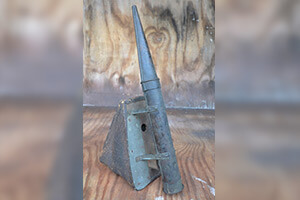
Since the mid 1970’s, I have collected bee smokers. Along with acquiring smokers, I try to identify who or what company made them. Over the years, I have managed to identify many of my manufactured smokers.
To identify old smokers, I search through the historical beekeeping literature. In the past, numerous small bee supply companies began and survived for a while. Typically, they perished by going out of business, although another company may have bought out some of the businesses. While smaller supply companies may have been franchises of large companies, and thus sold the smoker design of the larger home company, some small companies were independent and had their own smoker designs. Even smaller companies most likely published a supply catalog. For smoker identification, the right catalog is a gold mine, telling a smoker’s name, which could be one sitting on my shelf, unknown for decades. An example was the two rare Manum smokers we saw last month.
Besides bee supply catalogs, beekeeping periodicals are another way to identify bee smokers. About a hundred bee journals began publication. So potentially much material exists for smoker identification. An article might identify a smoker, but more likely an advertisement puts a name to the smoker. The difficulty is that prior to binding old periodicals, the advertisements, which were originally bound around the text of an issue, were often removed. The advertisement pages, appearing before and after the text of the issue were called the wraps. The issues were typically bound with the wraps off. That may have been done because of the repetitive nature of the advertisement among the consecutive issues and of course to decrease the binding width. Nevertheless, stripped of their advertisements, the issues lose a record of the commerce and creativity of the past, which was particularly tragic in the early years of our bee industry. Manufactured smokers, advertised briefly, maybe only for a few months, would be part of that loss. (Of course, one can look for a set of journals unbound or bound with the wraps on. All of that becomes exceedingly rare. If you ever buy a set of old bound bee journals, first ask if they have their wraps.) We will examine three of my “unknown” smokers, which were manufactured, not homemade, yet have kept quiet their pasts.
The first nameless unknown smoker, which I am calling the John Doe smoker, is I think the oldest smoker of the three smokers. It has the hallmarks of when smokers were first made (see Figure 1). Long and skinny are the most striking features of the John Doe smoker. Its total length is 17 inches, and the diameter of the “barrel,” which is called the firebox, is 1 and 5/8 inches, although it resembles a tube. Some old smokers have remarkably small diameters, providing space for only a thin strip of smoldering cloth. On the other hand, in the pantheon of old smokers, the John Doe smoker has an unusually large bellows.
The air connection between the firebox and bellows is an important design feature of a smoker. The connection on the John Doe smoker is quite unique. The metal pipe from the firebox inserted into a carved wooden pipe from the bellows. The metal and wood pipes form an airtight solid connection (see Figure 2). This airtight connection is a bad design flaw, a defect that began with the creation of the smoker itself.
In 1873, Moses Quinby from New York invented the smoker by attaching a bellows to a firebox with a funnel. The Quinby smoker was extremely practical, a giant leap forward from smoking bees with smudge pots or other awkward inefficient contraptions. But Quinby created his bee smoker with an airtight connection from the bellows to the firebox. Consequently, when a beekeeper set down Quinby’s smoker to handle the bees, the fire, lacking any airflow through it, quickly went out. The beekeeper became a defenseless intruder by an open hive full of irritated bees.
Quinby gave his smoker design freely to the beekeeping community, refusing to patent it. From old advertisements in the American Bee Journal, it appears Quinby sold his original smoker for about a year in 1874. Unfortunately, Quinby died suddenly in 1875 before correcting the smoker’s draft problem. (The patented smokers sold by Quinby’s son-in-law, L. C. Root, also from New York, are now called “Quinby” smokers, but they are not original Quinby smokers sold by Quinby himself. Furthermore, without a patent, many others copied Quinby’s smoker, keeping the funnel pointing …
Photo Caption
The first unknown smoker, which I am calling the John Doe smoker. This smoker is made from copper, a soft metal easy to bend, but also delicate and easy to destroy.


